Attended by civic leaders, diplomats
A large-scale traditional Korean religious rite and dance festival was held at the Ansan Art Center in the Ansan City of Gyeonggi Province, some 26 miles southwest of Seoul, on Oct. 23, 2015 with the attendance of Director Kim Bong-shik of the Ansan Art Center, Chairman Choi Soo-jin of GyeongsinYeonhaphoe (Federation of Korean Folk Religious Associations) and civic figures from the Ansan City, Seoul and Gyeonggi Province.
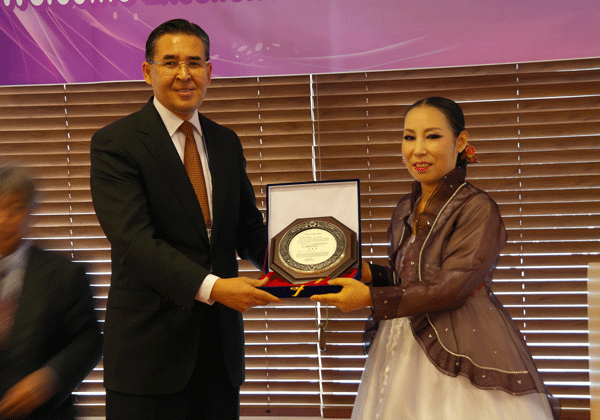
The traditional Korean Gut rite and dance performances were also attended by senior members of the Seoul Diplomatic Corps, who took interest in Korean culture and religion.
Officially named the 9th AnsanSeonghwang-gut Rite and Dance Festival, the traditional Korean folk religious (shaman) rite was hosted by President Lee Eun-sook of the Asian Seonghwang-gut Research Institute (ASRI) with the support of the Ansan Art Center, Ansan City and the Gyeonggi Province.
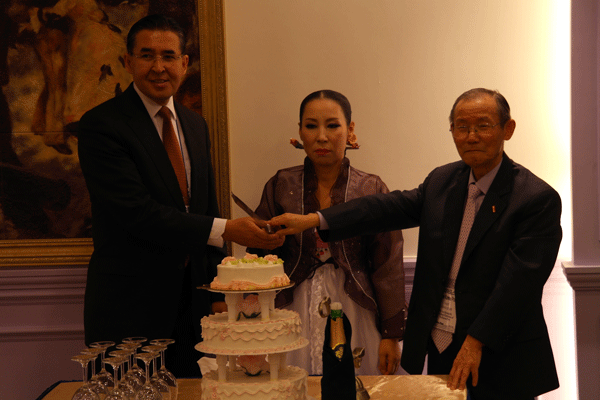
In a congratulatory message published in the introductory literature, Governor Nam Kyung-pil of the Gyeonggi Provincial Government said, “For more than 1,000 years, the people of Ansan City have been observing the Seonghwang-gut rite in October every year for the good luck and stability of the citizens of the City as well as harmony and unity of the villagers.” Then he expressed hopes that the traditional Korean folk religious rite will be properly preserved in the face of fast-changing social surroundings.
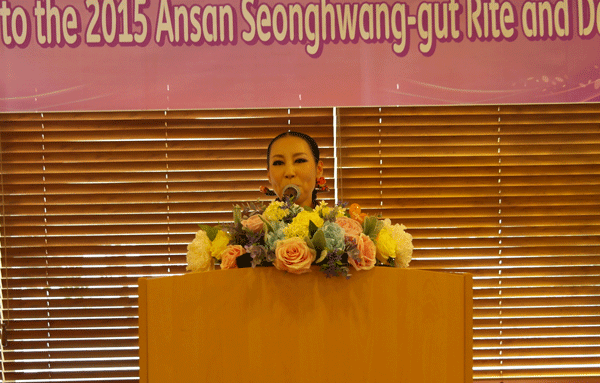
Mayor Je Jong-geel of the Ansan City, also in the introductory literature, said, “The AnsanSeonghwang-gut rite is an important part of the traditional Korean culture, which helped the Korean people maintain peace and healthy mind in the face of various difficulties they faced.” Then he hoped that the Korean people could develop the traditional Korean folk religious rite into a new sphere of culture.
Director Kim Bong-shik of Ansan Art Center congratulated President Lee Eun-sookof ASRI on the hosting of the large-scale Gut Rite for the blessings, happiness and good health of the 700,000 citizens of the Ansan City.

Congratulatory messages came also from National Assemblymen Kim Myung-hwan and Kim Myung-yun.
The former said that the AnsanSeonghwang-gut Rite and Dance Festival greatly contributed to the preservation and development traditional local culture of Ansan as well as to the promotion of peace and stability of the region.The latter praised the efforts of President Lee Eun-sook of ASRI, the host, stating that she provided an opportunity for the residents of the villages of the city to hear the problems of one another and share their wisdom and ideas to solve them, which contributed to the enhancement of social harmony and stability.
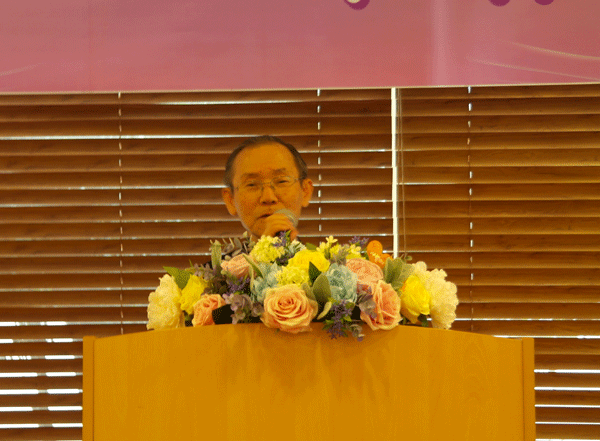
Director Kim, who joined the Festival later, played an active part by carrying a box of ritual food (two dried Pollack fishes) on the head and weaved through the guests sharing the good luck of the rite with them. The guests put money on the square box to be offered to the Mountain God of their village to bring them good luck and good health. This was also done to Mansin (the head Mudang or shaman) and the donated money is later used for a big party for all the participating guests.
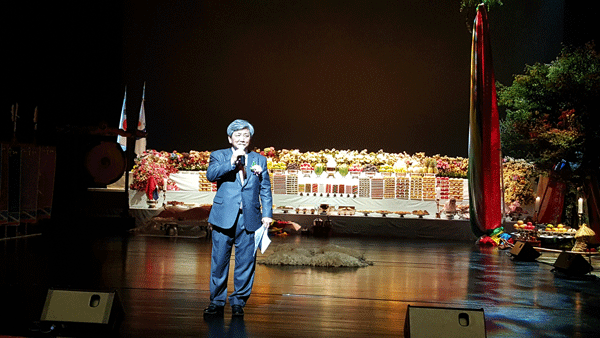
As soon as the opening performance by the Farmer’s Band was over on the stage, Professor Woo Jong-woong of Myungji University in Seoul introduced in detail each part of the Korean folk religious rite, the Seonghwang-gut in particular.
Then he gave a detailed explanation about the Seonghwang-gut Rite introducing each of the 10 parts of the program as well as the historical and traditional background of the Korean folk religious rite.
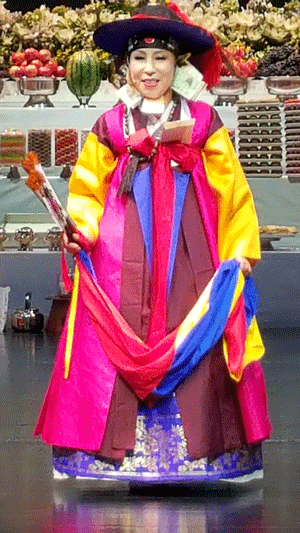
Professor Woo said, “The history and tradition of the Korean folk religion, Mugyo or Muism, date back to 9,000 years as they also cover the 4,000-year Era of Hwanin and Hwanung who precede Dangun, the Progenitor of the Korean nation, who founded ancient Joseon (Korea) Kingdom in Dangun Era 4348 (2015).”
Introducing the Korean shaman religion, Professor Woo explained that Hwanin (Heavenly King) and Hwanung (His Son) ruled ancient Korea before he gave birth to Dangun from his wife, Ungnyeo (Bear Woman), 4,348 years ago.

Today, there are many different religions in Korea, which include Buddhism, Catholicism, Protestantism, Islam, Confucianism, Taoism, Chundoism and various different sects of Buddhism such as Wonbulgyo and NammyoHorenGekyo (Japanese). They are all ‘imported’ religions from foreign countries and the only indigenous traditional Korean religion with such a long history and tradition is Mugyo known in the outside world as ‘shamanism.’

Mugyo is the ethnic religion of Korea and is known to have five to 15 million followers (Wikipedia). The practitioner is named Mudang (woman) and also Baksu (man) and also Mansin (萬神) for an aged and/or respectedMudang.
The role of the Mudang is to act as intermediary between the spirits or gods and the human plain through Gut (rituals), seeking to resolve problems in the patterns of development of human life.
Korean Mugyo has similarities with Chinese Wuism, Japanese Shintoism, and with the Siberian, Mongolian, and Manchurian religious traditions. As highlighted by anthropological studies, the Korean ancestral god Dangun is related to the Ural-Altaic Tengri "Heaven," the shaman and the prince. In some provinces of Korea the shaman is still called DangulDangul-ari. Mudang is similar to the Japanese Miko and the Ryukyuan Yuta.

The 9thAnsanSeonghwang-gut Rite and Dance Festival consisted of ten different parts (Geori), namely: SinkalDaesinmu Dance, Introduction, Binari, BonhyangsanGeori, Taepyeongmu Dance, JeseokGeori, SamulNori, SinjangDaegamGeori, Chaesinmu, and SeonghwangGeori.
SinkalDaesinmu Dance: Here the dancer used two bamboo canes each with a plenty of white paper tassels on both ends. It is based on an old Korean legend where the Princess danced with Sikal (a bamboo cane with white paper tassels) presented a dance at the deathbed of the King (her father) to guide him to the Paradise keeping the evil spirits away from the dying King. The Dance shows gestures and body movements indicating the ardent wishes of the Princess being accepted by the Heavenly King.

Introduction of Seonghwang-gut by Professor Woo: Professor Woo introduced in detail various aspects of Korean Mugyo as well as the Seonghwang-gut rite which is for the placating and pleasing Sansin (Mountain God) of Ansan.
Binari Dance: Binari deriving from Binaida (to pray) is a song and dance where prayers are given for keeping away bad spirits and hard luck away and to seek happiness, good health and affluence of the people in the village, region and country. In this dance, the Mugyo practitioner, or Mudang, conveys the wishes of the people to the God and provides them with words of blessing. Mudang also prays to God for longevity and wealth of the people.
BonhyangsanGeori: This is a traditional Korean folk religious ritual dance where prayers are given for the god of the people’s birthplace and the god of the places where their father and mother lived or live. Prayers are given also for the mountain god of the famous mountains of Korea.

Taepyeongmu Dance: Taepyeongmu (literally, "Great Peace Dance") is a Korean dance with the function of wishing a great peace for the country. Its exact origin is unknown, but Hahn Seongjun (a well-known dancer and drummer), rearranged the dance in the early 20th century. There are three assumptions regarding the origin of Taepyeongmu. One is a court dance occasionally performed by the Kings during the Joseon Dynasty. Therefore, the costumes used by the dancers are similar to Gwanbok formerly worn by Korea's Kings and Queens.
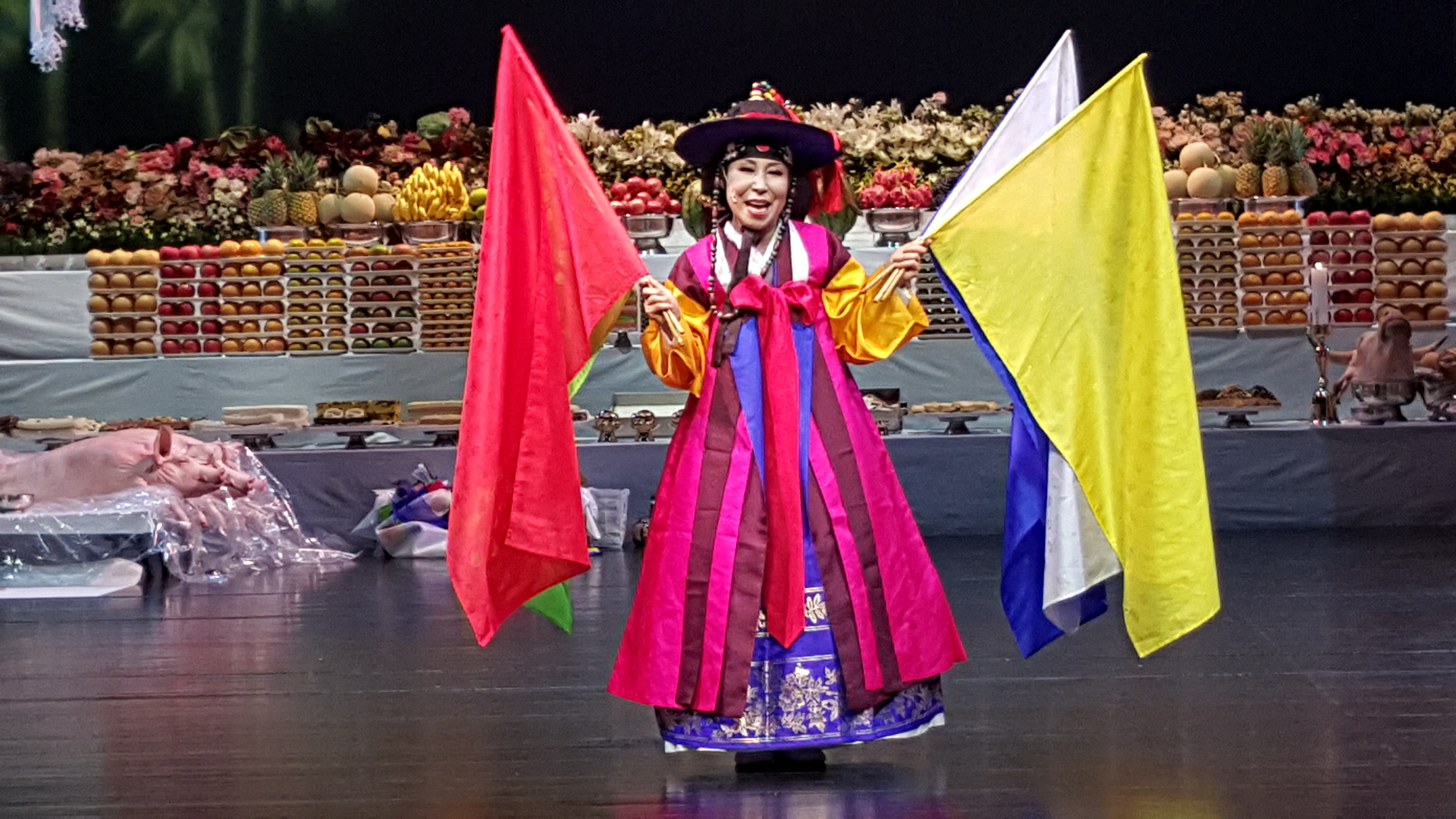
JeseokGeori: This is a Gut rite for Jeseok (Heavenly God) who stands for life and wealth of man, where no meat is used but rice cakes are used instead. Here the Mudang dancer wears a white conical headdress and white Buddhist robes and uses a folding fan in one hand and small tinkling bells in the other hand. The rite is in supplication for peace, good luck, good health of a family as well as for success in life such as appointment to a high-ranking position in the government and society. Jeseok (S’akrodevandra in Sanskrit), a title used for Hwanin (the grandfather of Dangun who is the Progenitor of the Korean nation), commands Sacheon-wang (Four Devas or Four Heavenly Guardians of Buddhism) and 32 other gods around him.
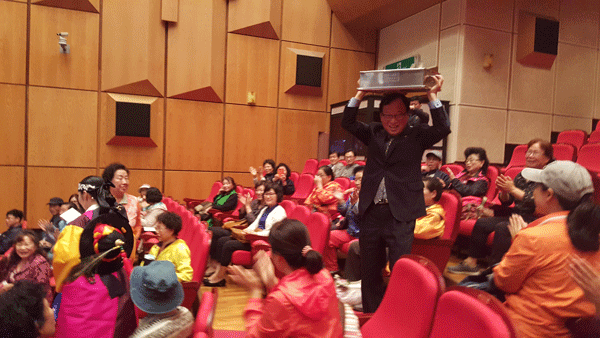
SamulNori Pan-Gut: This is a Gut rite based on SamulNori which is a genre of traditional percussion music originating in Korea. The word Samul means "four objects" and Nori means "play"; SamulNori is performed with four traditional Korean musical instruments consisting of: Kkwaenggwari (a small gong), Jing (a larger gong), Janggu (an hourglass-shaped drum) and Buk (a barrel drum similar to the bass drum). SamulNori has its roots in PungmulNori (literally "Korean traditional percussion instruments playing"), a Korean folk genre comprising music, acrobatics, folk dance, and rituals, which was traditionally performed in rice farming villages in order to ensure and to celebrate good harvests.
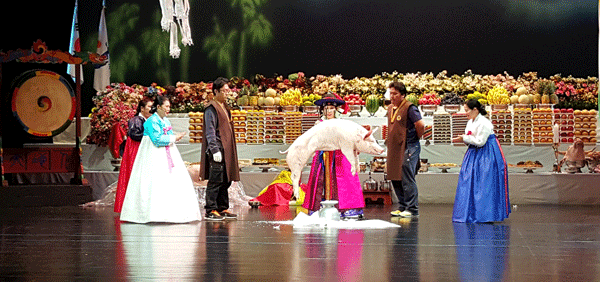
Specifically, SamulNori music derives from UtdariPungmul (the Gut, or shaman ceremony rhythm of the Gyeonggi-do and Chungcheong provinces of Korea).
SinjangDaegamGeori: In this rite, the Mudang dances with ObangSinjang-gi (literally, “Flags of Five Direction Divine Gods”) and offers the people to choose the flag to see what good luck (or hard luck) the choosers have. The Mudang invokes various Gods one after another and brings their blessings to the flag-choosers. The Mudang offers the guests rice wine from the five Direction Gods.
Chaeseon-mu Dance: This is a dance originally performed by Gisaeng (similar to Japan’s Geisha women entertainers), where the dancing women reveal their inner feelings, grievances and womanly fragrance through the medium of the folding fans they open and fold.
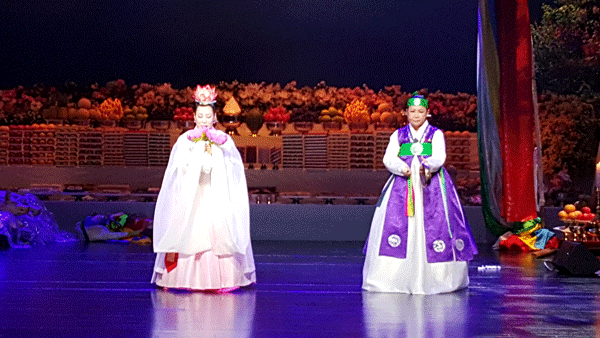
SeonghwangGeori: This is the main ritual event of the 9thAnsanSeonghwang-gut Rite and Dance Festival. The rite is for good luck and much blessings of the people the Ansan City which in the past was a small farming and fishing village. There is a Seonghwang-dang Mountain God Site on the Peak of the Nojeok-bong Hill InAnsan consisting of Kalopanax and Pine trees that are several hundred years old. There are traces of the Ansan Mountain God Shrine on the site. The Seonghwang Flag bearers invite the Mountain God of Ansan from this Mountain God Site and carry the flag all the way down to the Dalmaji Theatre of the Ansan Art Center, the venue of the 9thAnsanSeonghwang-gut Rite and Dance.
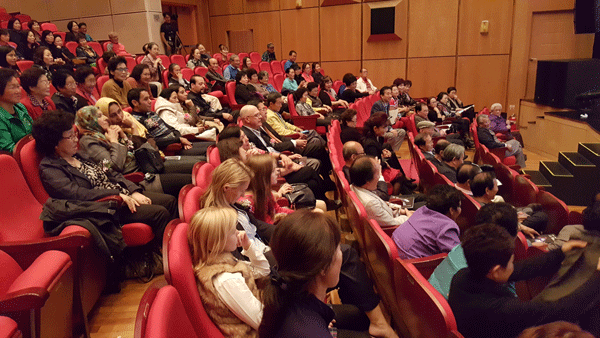
President Lee of ASRI, who played the role of the leading Mudang (Mansin) at the 9thSeonghwang-gut Rite and Dance Festitval, graduated from Myungji University, also heads the House of Nature in Ansan City and the Korean Folk Religious Newspaper as publisher and president. She is also a member of the Board of Trustees at the Federation of Korean Folk Religious Associations with 300,000 members across the country.

